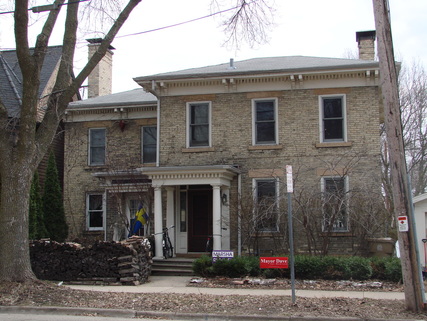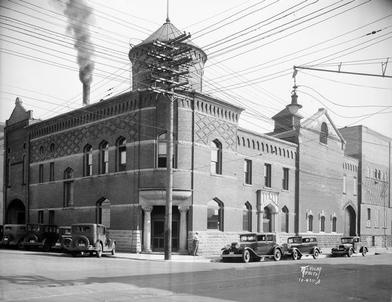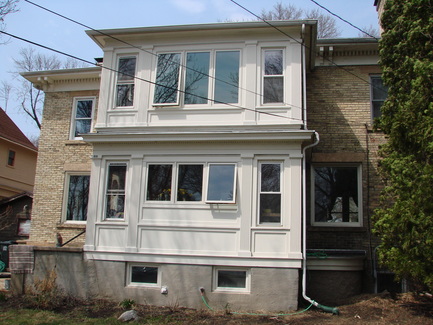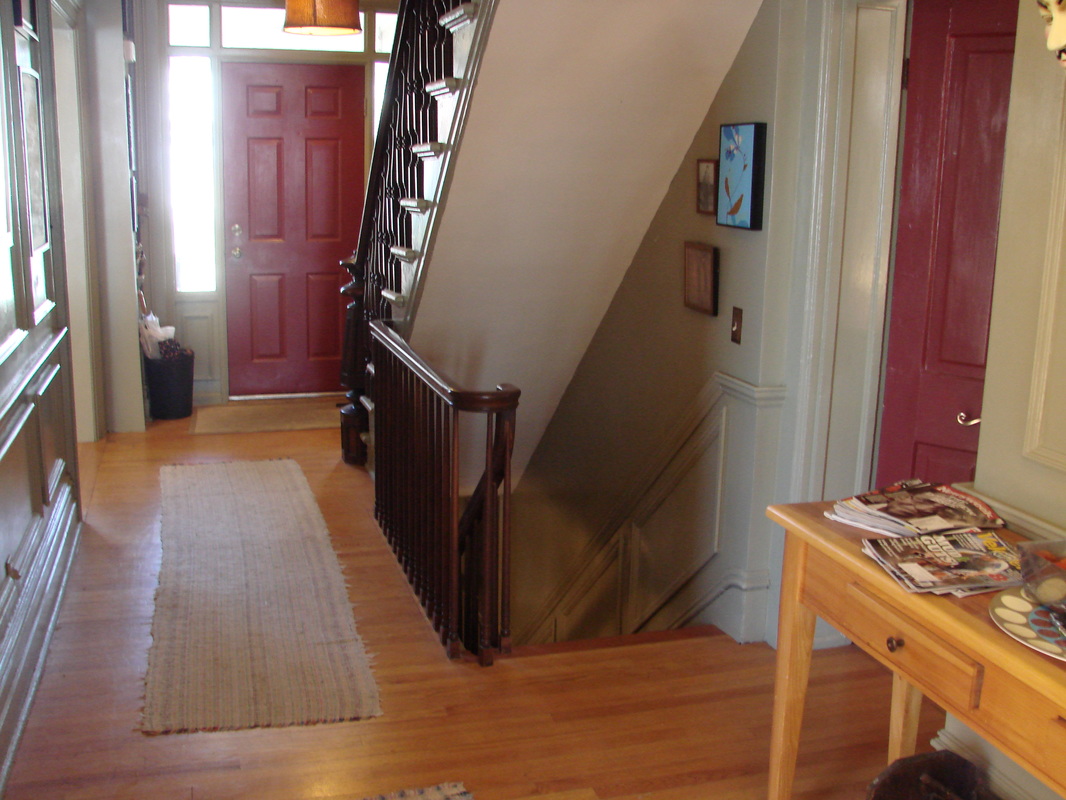Third Lake Ridge in Madison, Wisconsin
The information below summarizes final projects in the Spring 2011 course, Vernacular Architecture at UW-Madison, taught by Professor Anna Andrzejewski. That semester the class focused on vernacular architecture in the Third Lake Ridge historic district on the east side of Madison.

811 Jenifer Street
By Elzbieta Beck, Grace Latz, Emily Leggee, Mary Louis
The house at 811 Jenifer Street, constructed in 1866, is currently a two story brick dwelling with a wood-framed addition at the rear. The building was originally an irregular, rear-facing L-plan, but the transformation of the rear porch into additional indoor living space has made it a more complex, irregular house form. The foundation of the core of the home is limestone, though the portion of the foundation visible from the street has been coated in modern concrete, masking the original materials. The main part of the home still displays the original Cream City brick at the exterior, while the addition is covered in a white, stucco-style exterior material with molded column-like decorations.
The original dwelling on this plot was a two-story I-house structure. By 1882, 811 Jenifer had been rebuilt in the Cream City brick that exists at the core of the home today. The Italianate or Renaissance Revival style of the home is conspicuous in its low-pitched roof with eaves supported by simple, angular corbels. The windows and doors are arranged with a clean symmetry, and the modern widening of the ground story windows at the back is immediately obvious as a result. The high style dwelling is still at home in its urban midwestern setting, transformed by the local materials and environment. The front of the house faces north onto Jenifer, while the back faces a city beach on Lake Monona and provides a nearly 120-degree view of the water.
Owners included boot and shoemaker Gabriel Holver, contractor Hiram N. Moulton, the Olsen and Koberstein families, and Ted Coleman, the current owner. During Moulton’s nearly three-decade ownership the property changed significantly. By 1898 a two-story stable and outbuilding on the southeast side of the property had been torn down to accommodate a two-story framed Victorian house (now 820/822 Spaight). The western edge of the property also gained new two-story Victorian designed by the firm of Claude and Starck (807 Jenifer). By 1940, owners added a detached garage to accommodate automobiles. Building permits indicate interior renovations from 1969 to 1972.
From a simple, wood-framed structure at the outskirts of a new town, 811 Jenifer has transformed into a landmark house in a historic district in the center of a bustling urban environment.
By Elzbieta Beck, Grace Latz, Emily Leggee, Mary Louis
The house at 811 Jenifer Street, constructed in 1866, is currently a two story brick dwelling with a wood-framed addition at the rear. The building was originally an irregular, rear-facing L-plan, but the transformation of the rear porch into additional indoor living space has made it a more complex, irregular house form. The foundation of the core of the home is limestone, though the portion of the foundation visible from the street has been coated in modern concrete, masking the original materials. The main part of the home still displays the original Cream City brick at the exterior, while the addition is covered in a white, stucco-style exterior material with molded column-like decorations.
The original dwelling on this plot was a two-story I-house structure. By 1882, 811 Jenifer had been rebuilt in the Cream City brick that exists at the core of the home today. The Italianate or Renaissance Revival style of the home is conspicuous in its low-pitched roof with eaves supported by simple, angular corbels. The windows and doors are arranged with a clean symmetry, and the modern widening of the ground story windows at the back is immediately obvious as a result. The high style dwelling is still at home in its urban midwestern setting, transformed by the local materials and environment. The front of the house faces north onto Jenifer, while the back faces a city beach on Lake Monona and provides a nearly 120-degree view of the water.
Owners included boot and shoemaker Gabriel Holver, contractor Hiram N. Moulton, the Olsen and Koberstein families, and Ted Coleman, the current owner. During Moulton’s nearly three-decade ownership the property changed significantly. By 1898 a two-story stable and outbuilding on the southeast side of the property had been torn down to accommodate a two-story framed Victorian house (now 820/822 Spaight). The western edge of the property also gained new two-story Victorian designed by the firm of Claude and Starck (807 Jenifer). By 1940, owners added a detached garage to accommodate automobiles. Building permits indicate interior renovations from 1969 to 1972.
From a simple, wood-framed structure at the outskirts of a new town, 811 Jenifer has transformed into a landmark house in a historic district in the center of a bustling urban environment.
812 Jenifer Street: The Mosel Home and Syntropy Co-op
by Julia Griffith, Christine Huerta, Julie Jones, and Olivia Zabel
This two-and-a-half story, frame construction, eight-bedroom home was built for the Mosel family between 1909 and 1911. It is a four square, Arts and Crafts-style house with a stucco exterior, concrete foundation and a hipped, asphalt roof with a large central gable. The front porch, which is an open brick construction, has offset front steps leading to the front door. The first floor windows, especially those that look out onto the front porch, contain the original stained glass, which features natural motifs with purple and yellow flowers and green leaves. There is a carriage house in the backyard that, according to Sanborn maps and historical documents, was built around the same time as the home if not before. It is a frame construction and, just like the main house, it has a front gable dormer with a large window that has since been boarded up. This house has gone through relatively few changes over the years, including remodeling at the back of the house in 1942 and repairs to the porches and roof. Several interior details, including ionic columns carved in the wood detail on the fireplace and an elaborate mosaic on the front entry floor, remain in place.
The house’s open floor plan has accommodated its function as both a single-family residence and a co-op. The home was designed by Ferdinand Kronenberg and built for Frank and Emma Mosel and their five children. Frank Mosel worked for both the Brewer-Mosel Auto Company and the Madison Candy Company. One of their children was married in the home. The home was repossessed during the Great Depression and sold at public auction in 1930. Benjamin and Mabel Cowan bought the home in 1942; Benjamin died there suddenly in 1953 but Mabel owned it until the 1970s. They had a number of lodgers through the years who shared communal cooking and living space with the family. Following the Cowans, 812 Jenifer Street housed a theater group and, finally, a co-op. The Syntropy Co-op, owned by the Madison Community Cooperative since 1983, offers room rentals and communal meals to its members and operates a community garden where they raise chickens onsite.
This is an excellent example of an Arts and Crafts home with its dark wood moldings, stained glass, and built-ins. Though the home was designed for a single family, it has more recently operated as a community residence with relatively little change to its exterior or interior.
by Julia Griffith, Christine Huerta, Julie Jones, and Olivia Zabel
This two-and-a-half story, frame construction, eight-bedroom home was built for the Mosel family between 1909 and 1911. It is a four square, Arts and Crafts-style house with a stucco exterior, concrete foundation and a hipped, asphalt roof with a large central gable. The front porch, which is an open brick construction, has offset front steps leading to the front door. The first floor windows, especially those that look out onto the front porch, contain the original stained glass, which features natural motifs with purple and yellow flowers and green leaves. There is a carriage house in the backyard that, according to Sanborn maps and historical documents, was built around the same time as the home if not before. It is a frame construction and, just like the main house, it has a front gable dormer with a large window that has since been boarded up. This house has gone through relatively few changes over the years, including remodeling at the back of the house in 1942 and repairs to the porches and roof. Several interior details, including ionic columns carved in the wood detail on the fireplace and an elaborate mosaic on the front entry floor, remain in place.
The house’s open floor plan has accommodated its function as both a single-family residence and a co-op. The home was designed by Ferdinand Kronenberg and built for Frank and Emma Mosel and their five children. Frank Mosel worked for both the Brewer-Mosel Auto Company and the Madison Candy Company. One of their children was married in the home. The home was repossessed during the Great Depression and sold at public auction in 1930. Benjamin and Mabel Cowan bought the home in 1942; Benjamin died there suddenly in 1953 but Mabel owned it until the 1970s. They had a number of lodgers through the years who shared communal cooking and living space with the family. Following the Cowans, 812 Jenifer Street housed a theater group and, finally, a co-op. The Syntropy Co-op, owned by the Madison Community Cooperative since 1983, offers room rentals and communal meals to its members and operates a community garden where they raise chickens onsite.
This is an excellent example of an Arts and Crafts home with its dark wood moldings, stained glass, and built-ins. Though the home was designed for a single family, it has more recently operated as a community residence with relatively little change to its exterior or interior.
912 Jenifer Street
by Jennifer Baldwin, Lana Bates, and Taryn Ginsberg
Lew Porter designed this house in 1904. It is a two-and-a-half story duplex consisting of two separate units. The building, which is 3,312 square feet in total, contains four bedrooms, two full bathrooms, and two fireplaces. The exterior features a stone foundation, dark stained wood siding on the first level, salmon-colored stucco above, and an asphalt shingle roof. There are bay windows on the first and second stories. The property has a two-car garage at the end of a long, narrow concrete driveway. Notably, this Arts and Crafts home includes a porch with elaborate scroll-saw box pattern columns. George Grant Elmslie, a prominent Prairie School architect, first designed the scroll-saw box.
The home’s first residents included Rudolph Scheibel, a bookkeeper, and his wife, Mary (1904-1906); William and Gertrude Campbell and their daughter, Hazel, who was a student (1906-1914); Richard Rott, a mechanic (1914-1916); and William Lane, a conductor, his wife, Margaret, and their two children (1916-1919). In 1916, a Warranty Deed was signed over to Grantee Emelius A. Sorenson. When the Lane family moved out three years later, he moved in, and the home remained in the Sorenson family until 1977 when the current owner, David J. Nuzback, bought it. Emelius, who was known as “Happy” around town, worked at a barbershop on nearby Williamson Street until the age of 82. He had a short walking commute to work during that time. He had a wife, Anna, and a son, Russel. The Sorenson family added a detached garage to the home in 1932, which is to-date the most significant addition to the house.
Architect Lew F. Porter was born in 1862 in Peru, Illinois. He studied at Beloit College as a Civil Engineer and Architect. After graduation, his professor, Allan D. Conover, asked him to be a partner in an architecture firm, which became known as Conover & Porter in 1885. Their main office was in Madison, though they also kept offices in Ashland and Baraboo for some time. Their firm trained budding architects including Frank Lloyd Wright, Louis Claude, Alvin Small, and others, and designed government buildings, schools, banks, commercial structures, churches, and residences through 1899 when the two men ended their partnership. Porter then worked independently; his most notable solo project was the Wisconsin State Capitol Building, for which he served as Secretary and Supervising Architect in the 1906 Capitol Building Commission and then worked to ensure the quality of detailed construction until its completion in 1917. Porter also built the house at 912 Jenifer Street during his solo career, which ended when he died of kidney disease in 1918 at age 55.
by Jennifer Baldwin, Lana Bates, and Taryn Ginsberg
Lew Porter designed this house in 1904. It is a two-and-a-half story duplex consisting of two separate units. The building, which is 3,312 square feet in total, contains four bedrooms, two full bathrooms, and two fireplaces. The exterior features a stone foundation, dark stained wood siding on the first level, salmon-colored stucco above, and an asphalt shingle roof. There are bay windows on the first and second stories. The property has a two-car garage at the end of a long, narrow concrete driveway. Notably, this Arts and Crafts home includes a porch with elaborate scroll-saw box pattern columns. George Grant Elmslie, a prominent Prairie School architect, first designed the scroll-saw box.
The home’s first residents included Rudolph Scheibel, a bookkeeper, and his wife, Mary (1904-1906); William and Gertrude Campbell and their daughter, Hazel, who was a student (1906-1914); Richard Rott, a mechanic (1914-1916); and William Lane, a conductor, his wife, Margaret, and their two children (1916-1919). In 1916, a Warranty Deed was signed over to Grantee Emelius A. Sorenson. When the Lane family moved out three years later, he moved in, and the home remained in the Sorenson family until 1977 when the current owner, David J. Nuzback, bought it. Emelius, who was known as “Happy” around town, worked at a barbershop on nearby Williamson Street until the age of 82. He had a short walking commute to work during that time. He had a wife, Anna, and a son, Russel. The Sorenson family added a detached garage to the home in 1932, which is to-date the most significant addition to the house.
Architect Lew F. Porter was born in 1862 in Peru, Illinois. He studied at Beloit College as a Civil Engineer and Architect. After graduation, his professor, Allan D. Conover, asked him to be a partner in an architecture firm, which became known as Conover & Porter in 1885. Their main office was in Madison, though they also kept offices in Ashland and Baraboo for some time. Their firm trained budding architects including Frank Lloyd Wright, Louis Claude, Alvin Small, and others, and designed government buildings, schools, banks, commercial structures, churches, and residences through 1899 when the two men ended their partnership. Porter then worked independently; his most notable solo project was the Wisconsin State Capitol Building, for which he served as Secretary and Supervising Architect in the 1906 Capitol Building Commission and then worked to ensure the quality of detailed construction until its completion in 1917. Porter also built the house at 912 Jenifer Street during his solo career, which ended when he died of kidney disease in 1918 at age 55.
 Fauerbach Brewery in 1934
Fauerbach Brewery in 1934
848, 938, & 940 Spaight Street:
The Fauerbach Houses
by Amy Brabender, Jared Lowery, and Andrew J. Young
938, 940, and 848 Spaight Street are all connected to the Fauerbach family, who founded and owned Madison’s Fauerbach Brewing Company from 1891-1966. The houses are located with Lake Monona directly to the southeast and the industrial section of Madison two blocks to the northwest. The neighborhood consisted of mostly second-generation immigrants. The size of the houses and amount of prominent architects, such as Lew Porter and Claude & Starck, suggest that these residents were experiencing economic success. A notable thread linking these houses together is their proximity to the Fauerbach Brewery. Henry Fauerbach himself lived only three blocks from his family-owned and operated business. The family also owned other houses in the neighborhood.
The Henry and Elizabeth Fauerbach House at 938 Spaight, built in 1902, is a vernacular eclectic Queen Anne with a considerable amount of modifications. The two and a half story house rests on a square cut stone foundation with a regular course. The numerous bays and odd angles on the exterior of the house reflect a conventional feature of Queen Anne interiors. Other conventional Queen Anne features include a steep pitched roof, irregular floor plan, Palladian windows, and a Georgian oval-shaped window. Lew Porter, a prominent architect who designed buildings on the university campus as well as the Wisconsin State Capitol Building, constructed the home. 940 Spaight is a vernacular Greek Revival home with a considerable amount of modifications. The conventional characteristics of Greek Revival include a front facing pediment gable, intact cornice returns, and an original colonnaded portico entrance that no longer exists. 848 Spaight is a vernacular Queen Anne style home that, like 938, was also designed by Lew Porter. Prominent design elements include a grandiose front porch, a Greek-revival style pediment gable with cornice returns, Palladian/Georgian semi-circle windows, Greek-revival-style dormers with Georgian windows, and Jacobean-style English diamond-pane windows. There are Arts and Crafts influences as well, as noted in the simplified lines and ornamentation. Drawing from a number of revival styles, the house was built for Charles F. Lamb. Lamb was related to the Fauerbachs by marriage.
Henry Fauerbach was just two years old in 1868 when his mother and father, Peter and Maria, moved to Madison because Peter had purchased the Sprecher Brewery, which would eventually become the Fauerbach Brewing Company. There were five other children in addition to Henry: Louis, Charles, Philip, Emil, and William. Peter ran the brewery until his death in 1886, at which point Maria took over the business and eventually incorporated it in 1891. The Fauerbachs resided at the brewery until 1891, when Maria, Henry and his new wife Elizabeth, and brother Emil moved to 940 Spaight Street. The other Fauerbach brothers also moved to homes in the Third Lake Ridge neighborhood. As business increased, Henry purchased the neighboring lot and had the house built at 938 Spaight Street. The home at 938 Spaight served as an anchor for the Fauerbach family, with many members moving around the neighborhood and living at this address. Henry, who was the Vice President of Fauerbach Brewing, became a prominent Madisonian and a member of social organizations such as the Masons, Elks, the Madison Club, and the Maple Bluff Country Club. He lived at 938 Spaight until his death in 1936.
The location of the Fauerbach Brewery, 938 Spaight, 940 Spaight, 848 Spaight, and the other Fauerbach residences is typical of early-twentieth and late-nineteenth century living patterns in an industrial-based economy and urban environment. Before the advent of reliable transportation, the necessity to reach the family business in a short amount of time tied the Fauerbachs to the landscape. The fact that Maria and her adult sons lived in close proximity reflects social patterns of German first and second-generation immigrant families who frequently resided in the same neighborhood. Socially, the Fauerbach children assimilated into Madison while still maintaining a close family network. Philip Fauerbach’s marriage to a prominent Madison attorney’s daughter, Ellen Lamb, is a testament to this. Ellen’s brother, Charles, would follow in their father’s footsteps and also become a prominent Madison attorney and would eventually move into 848 Spaight, down the street from Henry Fauerbach. Additionally, women have played a prominent role in the history of the brewing company. Maria ran the business for five years (1886-1891) after her husband, Peter, passed away. Additionally, Amelia, (Louis’s wife) was President in 1907.
The Prohibition (1920-1933) and the Great Depression in 1929 dealt several blows to the Fauerbachs and their business. During these lean years, they owned other properties to help keep the brewery open. Unfortunately, despite Henry’s efforts to utilize the New Deal’s homeowners’ loan program, Henry and Elizabeth’s house at 940 Spaight went into foreclosure in 1936 and in the early 1940s the family sold 938 Spaight Street. Regardless of these losses, the Fauerbach Brewing Company remained open until 1966. It was the last surviving original Madison brewery, and with its closure, the third generation of Fauerbachs eventually moved out of the neighborhood. The Third Lake Ridge Neighborhood, however, maintains the Fauerbach legacy and sense of place in numerous ways: a condo building named The Fauerbach stands where the brewery once was; Peter Fauerbach, a resident of Madison and one of the current descendents of the Fauerbach family, began making his family’s beer again in the early 2000s with conjunction with Gray’s Brewing Company and can be found in local bars; and many of the original Fauerbach houses still remain occupied in the neighborhood.
The Fauerbach Houses
by Amy Brabender, Jared Lowery, and Andrew J. Young
938, 940, and 848 Spaight Street are all connected to the Fauerbach family, who founded and owned Madison’s Fauerbach Brewing Company from 1891-1966. The houses are located with Lake Monona directly to the southeast and the industrial section of Madison two blocks to the northwest. The neighborhood consisted of mostly second-generation immigrants. The size of the houses and amount of prominent architects, such as Lew Porter and Claude & Starck, suggest that these residents were experiencing economic success. A notable thread linking these houses together is their proximity to the Fauerbach Brewery. Henry Fauerbach himself lived only three blocks from his family-owned and operated business. The family also owned other houses in the neighborhood.
The Henry and Elizabeth Fauerbach House at 938 Spaight, built in 1902, is a vernacular eclectic Queen Anne with a considerable amount of modifications. The two and a half story house rests on a square cut stone foundation with a regular course. The numerous bays and odd angles on the exterior of the house reflect a conventional feature of Queen Anne interiors. Other conventional Queen Anne features include a steep pitched roof, irregular floor plan, Palladian windows, and a Georgian oval-shaped window. Lew Porter, a prominent architect who designed buildings on the university campus as well as the Wisconsin State Capitol Building, constructed the home. 940 Spaight is a vernacular Greek Revival home with a considerable amount of modifications. The conventional characteristics of Greek Revival include a front facing pediment gable, intact cornice returns, and an original colonnaded portico entrance that no longer exists. 848 Spaight is a vernacular Queen Anne style home that, like 938, was also designed by Lew Porter. Prominent design elements include a grandiose front porch, a Greek-revival style pediment gable with cornice returns, Palladian/Georgian semi-circle windows, Greek-revival-style dormers with Georgian windows, and Jacobean-style English diamond-pane windows. There are Arts and Crafts influences as well, as noted in the simplified lines and ornamentation. Drawing from a number of revival styles, the house was built for Charles F. Lamb. Lamb was related to the Fauerbachs by marriage.
Henry Fauerbach was just two years old in 1868 when his mother and father, Peter and Maria, moved to Madison because Peter had purchased the Sprecher Brewery, which would eventually become the Fauerbach Brewing Company. There were five other children in addition to Henry: Louis, Charles, Philip, Emil, and William. Peter ran the brewery until his death in 1886, at which point Maria took over the business and eventually incorporated it in 1891. The Fauerbachs resided at the brewery until 1891, when Maria, Henry and his new wife Elizabeth, and brother Emil moved to 940 Spaight Street. The other Fauerbach brothers also moved to homes in the Third Lake Ridge neighborhood. As business increased, Henry purchased the neighboring lot and had the house built at 938 Spaight Street. The home at 938 Spaight served as an anchor for the Fauerbach family, with many members moving around the neighborhood and living at this address. Henry, who was the Vice President of Fauerbach Brewing, became a prominent Madisonian and a member of social organizations such as the Masons, Elks, the Madison Club, and the Maple Bluff Country Club. He lived at 938 Spaight until his death in 1936.
The location of the Fauerbach Brewery, 938 Spaight, 940 Spaight, 848 Spaight, and the other Fauerbach residences is typical of early-twentieth and late-nineteenth century living patterns in an industrial-based economy and urban environment. Before the advent of reliable transportation, the necessity to reach the family business in a short amount of time tied the Fauerbachs to the landscape. The fact that Maria and her adult sons lived in close proximity reflects social patterns of German first and second-generation immigrant families who frequently resided in the same neighborhood. Socially, the Fauerbach children assimilated into Madison while still maintaining a close family network. Philip Fauerbach’s marriage to a prominent Madison attorney’s daughter, Ellen Lamb, is a testament to this. Ellen’s brother, Charles, would follow in their father’s footsteps and also become a prominent Madison attorney and would eventually move into 848 Spaight, down the street from Henry Fauerbach. Additionally, women have played a prominent role in the history of the brewing company. Maria ran the business for five years (1886-1891) after her husband, Peter, passed away. Additionally, Amelia, (Louis’s wife) was President in 1907.
The Prohibition (1920-1933) and the Great Depression in 1929 dealt several blows to the Fauerbachs and their business. During these lean years, they owned other properties to help keep the brewery open. Unfortunately, despite Henry’s efforts to utilize the New Deal’s homeowners’ loan program, Henry and Elizabeth’s house at 940 Spaight went into foreclosure in 1936 and in the early 1940s the family sold 938 Spaight Street. Regardless of these losses, the Fauerbach Brewing Company remained open until 1966. It was the last surviving original Madison brewery, and with its closure, the third generation of Fauerbachs eventually moved out of the neighborhood. The Third Lake Ridge Neighborhood, however, maintains the Fauerbach legacy and sense of place in numerous ways: a condo building named The Fauerbach stands where the brewery once was; Peter Fauerbach, a resident of Madison and one of the current descendents of the Fauerbach family, began making his family’s beer again in the early 2000s with conjunction with Gray’s Brewing Company and can be found in local bars; and many of the original Fauerbach houses still remain occupied in the neighborhood.
| fauerbachhouses.pdf |



